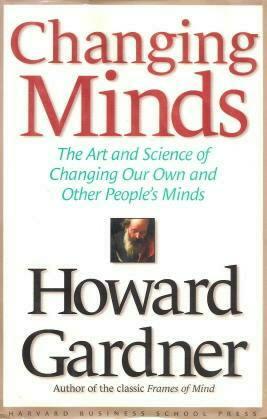 The following review was posted in February, 2010. Review of Changing Minds: The Art and Science of Changing Our Own
and Other People's Minds, by Howard Gardner. Harvard Business
School Press, 2004, 244 pp. Reviewed by Mary Meehan Howard Gardner, a Harvard professor of education and psychology, has written a whole herd of important books. Both in this book and elsewhere, he has done yeoman's work to liberate us from the tyranny of IQ (Intelligence Quotient)--the idea that there is just one kind of human intelligence. Instead, he argues persuasively that there are different kinds: linguistic, logical-mathematical, musical, spatial, and so on. Contending that people often are stronger in one kind than another, he tells the story of a checkout cashier in the academic stronghold of Cambridge, Mass. She saw a student who was trying to go through the express line with far more items than the clearly-posted limit. Her question: "So, is it that you go to MIT and you can't read--or that you go to Harvard and you can't count?" In this book, Gardner explores how minds can be changed "about things that matter." He focuses on political, business, scientific, and artistic leaders who have changed minds in significant ways. His subjects include Charles Darwin, Mohandas Gandhi, Margaret Thatcher, a college president, and two BP executives who changed the oil company's corporate culture. He also tells a few stories about people who failed when they tried to change minds. Especially interesting is his account of how Lawrence Summers, then president of Harvard University, alienated Prof. Cornel West, a leading African American scholar. (West voted with his feet by leaving Harvard and returning to Princeton.) Gardner suggests a more positive and creative approach that Summers could have used in dealing with West. He is so effective here that I wish he had used more stories about people who failed in mind-changing, but might have succeeded with a different approach. One of Gardner's best success stories is the reconciliation between John Adams and Thomas Jefferson in their old age. Spurred by their mutual friend Benjamin Rush, the two started a long and fascinating correspondence. "You and I ought not to die before we have explained ourselves to each other," Adams told his old rival. Gardner says they found common ground and had "a mutual changing of minds." Adults, though, often find it very hard to change their minds. Gardner remarks that people "go to great lengths to square apparently discrepant information with their firmly held beliefs," and he suggests that intellectuals are especially prone to do this. "It may not be easy for nonintellectuals to appreciate," he says, "how much stock members of this group place in being right, in being able to defend their positions articulately, and in remaining consistent"; but, after all, "ideas are the central axis for any intellectual." So when "an occurrence runs counter to their theory, they are highly motivated to reinterpret events so as to eliminate the inconsistency." He notes that many intellectuals, for example, remained committed to Communism in the last century despite much evidence of its murderous brutality in practice. Whittaker Chambers, a journalist who turned away from Communism and attacked it publicly, was a rare and brave exception. No one should be surprised that it's "easier to talk about changing minds in general than to effect enduring changes in any particular mind." Yet it can be done. Gardner lists seven factors or levers of mind change, describing each with a word starting with "re" (reason, research, resonance, real world events, and so on). His weakness for alliteration leads to one complicated-sounding term, "representational redescriptions," that is quite important. It just means using different formats to make the same point. This fits with Gardner's theory of "multiple intelligences" and also with learning experiences that many of us can recall. As he says, people "learn most effectively when they can receive the same message in a number of different ways, each re-presentation stimulating a different intelligence." Dealing with how a leader can "tell a compelling story about a new vision for change," he makes one of the book's best points: "...while stories need to be dramatic, motivating, memorable, picturesque, even garlanded with appropriate music and graphics, they also need to be honest.... When all is said and done, then, the most important ingredient for a story to embody is truth; and the most important trait for a leader to have is integrity." Gardner emphasizes the power of leaders who practice in their lives the values they advocate. Mohandas Gandhi, Nelson Mandela, and French statesman Jean Monnet, he says, did not tell a simple but brutal story, as so many twentieth-century dictators did. "Rather, they took on a far more daunting task: to develop a new story, tell it well, embody it in their lives, and help others understand why it deserves to triumph..." The book includes several descriptions of how and why Gardner changed his own mind on key issues. He suggests that all of us should find our own best ways of learning, given "one's own idiosyncratic array of intelligences and stupidities." He estimates that "accurate self-knowledge is worth at least 15 to 25 IQ points--and that's a lot!" While Changing Minds is not a how-to-do-it manual, it offers many helpful insights to ponder. Gardner occasionally rambles a bit, but he is an engaging writer and a good one to stroll with on byways as well as the main path. You may find, as I have, that you want to ramble on to other Gardner books.  |